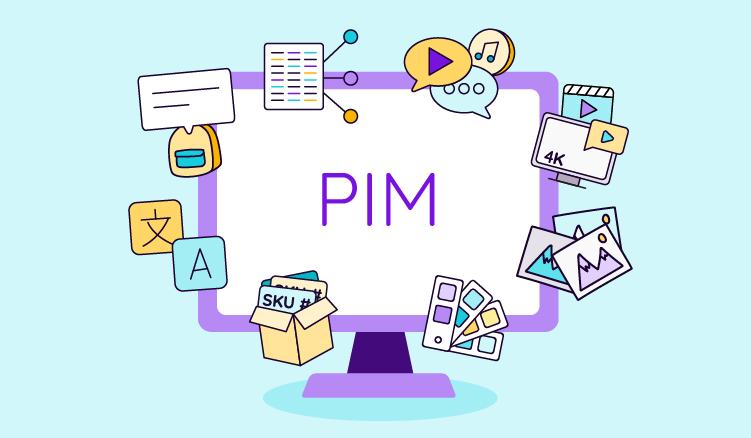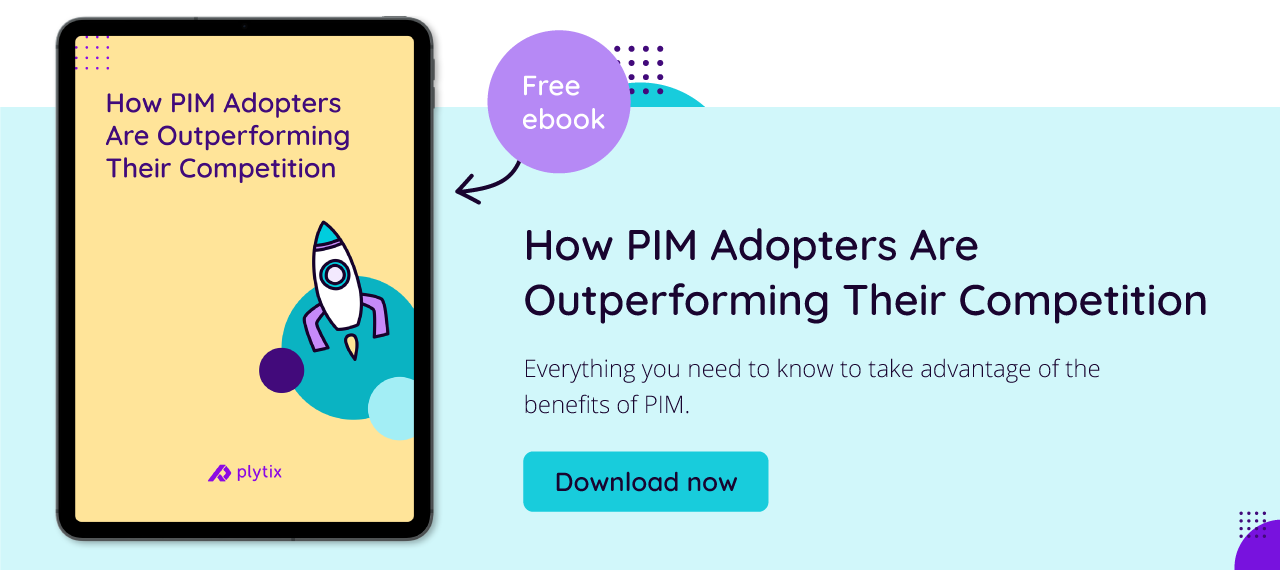
Keep the good stuff coming
Subscribe to our blog newsletter and get monthly content that helps you manage product data smarter.
No spam. Just real value.
Product Information Management software (or PIM) is getting more and more popular every year, as more and more companies embrace a new, more efficient way to handle all the data involved in ecommerce. But what kinds of data can PIM actually help with? The name doesn’t exactly go into detail—after all, ”product information” could technically mean anything from initial designs and blueprints to current sales figures to user-generated reviews and content.
To make up for the name’s (somewhat ironic) lack of information, I’ve put together this guide to the seven most typical types of product information and data that PIM software can handle. Each category also includes some real-life examples, so you can get a really clear idea of the capabilities of this tech and see if it would be a good fit for your business.
1. Essential product data
First up is the bread and butter of any ecommerce business—the data that identifies your products. This includes technical data like SKUs and UPCs, along with things like product titles, labels, and basic descriptions. PIM systems excel in handling these details and keeping critical information consistent across all sales channels.
A fashion retailer, for instance, can use PIM to make sure that the SKU and GTIN are accurately recorded and consistent across all sales platforms for every shirt that it sells and that the right product titles and descriptions are associated with each one. This is crucial for avoiding things like pricing discrepancies or mislabelled products, which can directly impact sales and customer satisfaction—and not in a good way.
Typical essential product data and examples:
Internal reference code/numbers- SKU: Stock Keeping Unit (e.g. PLT-10316)
- UPC: Universal Product Code (e.g. 799439112766)
- GTIN: Global Trade Item Number (e.g. 00012345678905)
- ASIN: Amazon Standard Identification Number (e.g. B0B2KPCBJZ)
- Oxford Button-Down Shirt, men’s XL, purple
- This lightweight yet sturdy button-down shirt is sure to give your wardrobe a touch of class. Made from the finest cotton, the rich purple tones offset the cream buttons wonderfully—you’re sure to turn some heads.
2. Product details
In addition to fundamental product information, PIM software can manage a wide range of additional details about your products. This includes physical attributes like size, color, and material, as well as more specific measurements and other specifications that help in distinguishing between similar products.
For example, an online appliance store can use PIM to manage data about the technical details of its various home appliances, or the materials and colors of each one. This additional data helps customers make informed decisions by providing detailed comparisons between products, so nobody ends up with a tiny travel-sized hairdryer when they were looking for a more heavy-duty, salon-quality option.
Typical product details and examples:
Size- regular / travel
- 25.5 x 16.5 x 22.5 centimeters
- 499 grams
- black / blue / silver
- plastic / metal
- 2000W
3. Product taxonomy data
Product taxonomy involves how products are categorized within a system, which is essential for easy navigation and efficient management. This could mean literally sorting products into categories and subcategories, setting up “parent” products that have multiple variations, or establishing other relationships between different products—think accessories, components, bundles, upsell options, and downsell options.
For example, an electronics retailer might use PIM to group the products on its website into specific categories like smartphones, tablets, and laptops. Those categories could then have further subcategories based on features like brand, model, and price range, and then each individual model might have variations based on color or storage capacity.
Finally, having related products would give the retailer the option to show recommended accessories alongside each product at the moment of purchase, like cases or screen protectors. This structured approach makes it easier for customers to find the products they need—whether they knew they needed those products or not 👀
Typical product taxonomy attributes and examples:
Category - Telephone
- > Smartphone
- >> Samsung
- >>> Galaxy
- Samsung Galaxy A55
- 128GB / 256GB
- black / light blue / light violet / yellow
- Samsung Galaxy headphones
- Samsung Galaxy A55 phone cases
4. Digital assets
A comprehensive PIM system also supports the management of digital assets. These are typically media files like images, videos, audios, and documents (think product manuals in PDF form, for example). These assets are crucial for ecommerce as they provide customers with valuable information, helping to drive sales and improve user engagement. I mean, let’s be honest here—do you really expect people to buy something without seeing it first?
A sneaker retailer, for example, can use PIM to manage high-resolution images for each piece of footwear that it sells, alongside care instructions and videos of the sneakers in use (ideally by overly-photogenic celebrities, but authentic UGC can’t be overlooked either). These assets are vital for engaging customers and providing a rich online shopping experience.
Typical digital assets and examples:
Marketing material- hero shots
- packshots
- lifestyle shots
- promotional videos
- unboxing videos
- user photos
- review podcasts
- manuals
- warranties
- terms and conditions
5. Marketing and sales data
Marketing and sales data is another area where PIM software really shows its strength. This includes SEO keywords, product catalogs, sales enablement documents, and customer testimonials or reviews. By centralizing this data, PIM helps you keep marketing efforts consistent across all platforms while tailoring your content to make it resonate with your target audience.
A cosmetics company might use PIM to centralize the SEO terms associated with each product, which can then be used to improve search engine rankings and drive traffic to product pages. Additionally, managing sales enablement documents through PIM means that all sales representatives have up-to-date product information at their fingertips, which can make all the difference when they're trying to close a deal.
Typical marketing and sales data and examples:
SEO keywords- eyeshadow, palette, glitter, shades, shadow, shimmers
- PDFs of different ranges/seasonal collections
- product sheets
- ebooks
- case studies
- white papers
- “We've been distributing on behalf of NYX Cosmetics for the past decade, and the quality of their products has never wavered. As a company, they are incredibly communicative, always forthcoming about their future plans and excellent at delivering the stock we need on time.”
- “Really good quality for a great price. Load of warm shades of browns and neutral tones. Just as described—five stars! ⭐⭐⭐⭐⭐ “
6. Localized content
For businesses operating in multiple geographical regions, localized content is essential. PIM systems can handle translations and regional versions of product data, as well as manage pricing in different currencies. This capability makes it much easier to meet all market-specific requirements, like compliance with local regulations, and to connect with the local customer base much more effectively.
For instance, a global sports equipment provider can use PIM to adapt product descriptions, pricing, and currency for different regions and make sure that all information is relevant and compliant with local market standards. To really win this game though, they could even include references to local sports teams or players that vary depending on the area—think featuring the Lakers in L.A., the Cowboys in Dallas, and of course Ryan Reynolds and Rob McElhenney in Wrexham.
Typical localized content and examples:
Multilingual content- Find your drive within and push yourself further in the game with the Wilson NBA DRV Plus basketball. Designed for outdoor courts, the performance cover provides grip even on the roughest surfaces.
- Encuentra tu motivación interna y esfuérzate más en el juego con el balón de baloncesto Wilson NBA DRV Plus. Diseñada para canchas al aire libre, la cubierta de alto rendimiento ofrece agarre incluso en las superficies más ásperas.
- Hey, San Francisco—wanna shoot like Curry?
- Hey, Phoenix—wanna shoot like Durant?
- Hey, L.A.—wanna shoot like LeBron?
- $27.99 / 26,49€ / £22.49 / ¥4,290
7. Channel-specific content
Channel-specific content tailoring is crucial for businesses that operate across multiple online platforms. Using PIM, a retailer can optimize product data for different channels like Amazon, eBay, and their own ecommerce site. This means adjusting product titles, descriptions, and metadata to meet the specific requirements of each platform, boosting visibility and sales potential.
For example, a health supplements company can make use of PIM to optimize its channel-specific content by adjusting product titles and descriptions for their offerings across different platforms like Amazon, eBay, and their own website.
On Amazon or eBay, product titles might emphasize 'bestseller' status or key benefits like 'immune support' to catch the eye of health-conscious shoppers browsing through a sea of options. Meanwhile, on their website, they could provide deeper educational content about the benefits and scientific backing of their products to build trust, encourage longer engagement, and ultimately keep their sales looking as healthy as their customers.
Typical channel-specific content and examples:
Title variations- Nature's Bounty Biotin, Supports Healthy Hair, Skin and Nails, 10,000 mcg, Rapid Release Softgels, 120 Ct (Amazon)
- Nature's Bounty EXTRA STRENGTH HAIR SKIN NAILS ARGAN OIL INFUSED BIOTIN Softgels (eBay)
- Extra Strength Hair, Skin & Nails (naturesbounty.com)
- Nature’s Bounty Biotin softgels help support healthy hair, skin, and nails to help keep you looking and feeling your best. (Amazon)
- With Nature’s Bounty Optimal Solutions Hair, Skin & Nails formula with Argan Oil, you’ll look good and feel great! It contains just the right balance of nutrients to help support lustrous hair, strong nails and vibrant skin. (eBay)
- Nature’s Bounty® Optimal Solutions® Hair, Skin & Nails formula contains balanced nutrients to help you continue to look and feel your best. (naturesbounty.com)
- categorization on Google
- Shopify handles
- attribute naming conventions for different platforms/websites
Bonus type: Anything else you can imagine!
While PIM is mainly used for managing structured product information, its integrated DAM functionality means it can actually store virtually any data, even if it cannot directly process or read it. This flexibility is incredibly useful for businesses that deal with a massive amount of unstructured data and files scattered around a bunch of different systems, since it gives them one centralized repository where they can store everything.
Get the information you need
PIM software isn't just about keeping your data organized; it's about making your data work harder for your business. By managing everything from basic product details to complex digital assets and channel-specific content, PIM provides a structured framework to support efficient ecommerce strategy.
To delve deeper into how PIM can transform your business and place you ahead of the curve, download our comprehensive ebook that talks about exactly that subject! It’s got more statistics than I can count, case studies that show real-life companies benefitting from PIM, and a comparison of five of the top PIM providers on the market. Don't let your business lag behind—embrace PIM and watch your business overtake the competition!
FAQs
A Product Information Management (PIM) system manages various types of data including essential product identifiers (SKUs, UPCs), detailed product descriptions, digital assets like images and videos, marketing and sales information, localized content for different regions, and channel-specific details for various sales platforms.
PIM includes functions to centralize, manage, and distribute product information efficiently. This includes handling details such as product descriptions, specifications, digital assets like images and videos, as well as marketing and sales data. It helps maintain consistency across multiple sales channels, aids in SEO optimization, and facilitates the management of localized and channel-specific content tailored to different markets.
There are various examples of PIM software on the market at the moment, and software review sites like G2 are a good place to start your search. We’d also like to mention Plytix as a popular example of a PIM tool in 2024, that offers capabilities to handle extensive product information across different channels, maintain data consistency and generally boost your ecommerce operations.
PIM is used to centralize and manage all product-related information, making it easier for companies to maintain consistent and accurate product data across multiple sales channels. This enhances customer experience, improves marketing effectiveness, and supports global sales strategies by managing localized and channel-specific content.

What if your product data actually worked for you?
We’ll show you how Plytix helps you stop fixing data—and start using it.
Related posts
Keep the good stuff coming
Subscribe to our blog newsletter and get monthly content that helps you manage product data smarter.
No spam. Just real value.








Think others should see this?
Go ahead and share it.